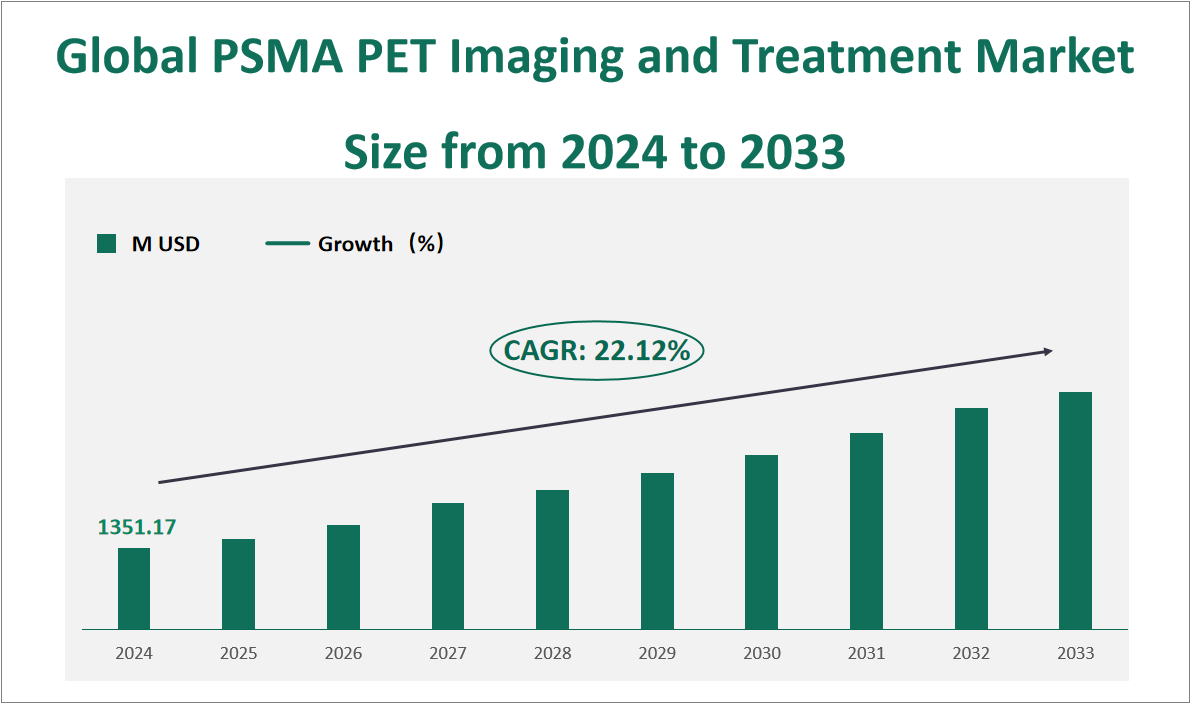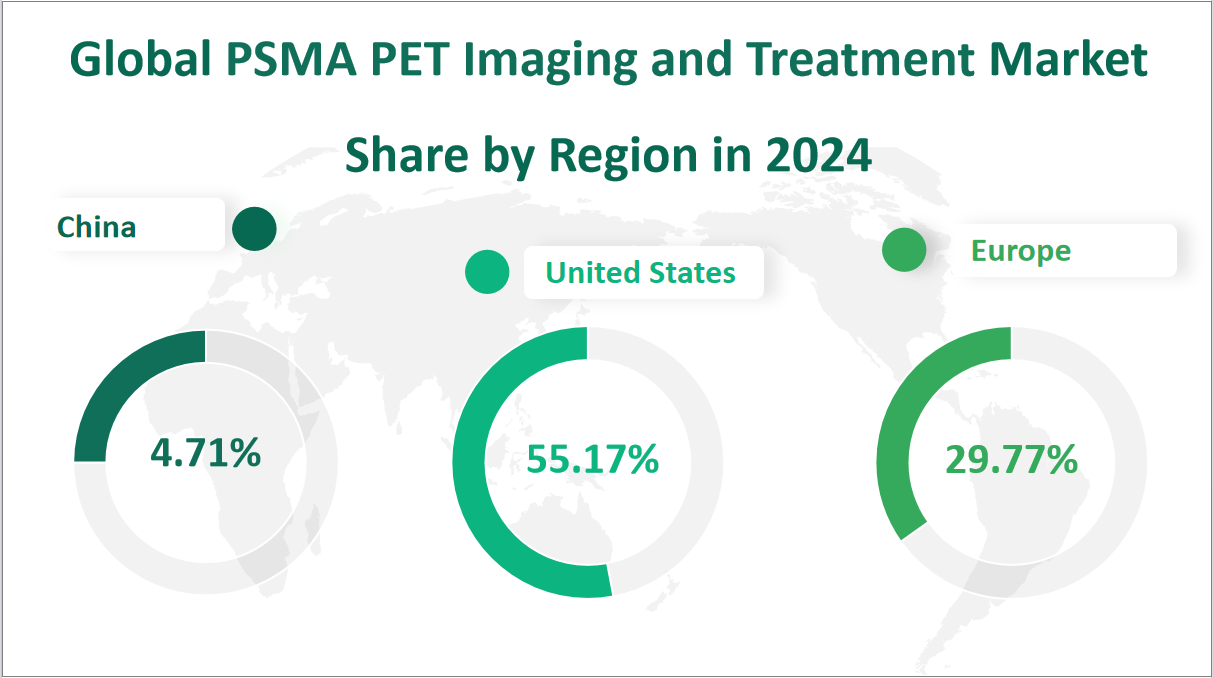1 Global PSMA PET Imaging and Treatment Market Outlook
The global PSMA PET Imaging and Treatment market is projected to exhibit substantial growth in the coming years, with a CAGR of 22.12% from 2024 to 2033, reaching a total market size of $1351.17 million USD in 2024. Prostate-specific membrane antigen (PSMA) is a transmembrane protein that is expressed in high levels in prostate cancer cells. Due to its location on the cell surface, PSMA is a popular target for imaging to identify the presence of prostate cancer and to deliver drugs directly to the cancerous cells. PSMA PET Imaging mainly refers to a new imaging technology of prostate cancer that can locate cancer lesions. Currently, PSMA PET uses FDA-approved PET-sensitive drugs. PSMA PET Imaging and Treatment involves diagnosing prostate cancer, improving symptoms, and reducing tumor size.
Figure Global PSMA PET Imaging and Treatment Market Size and Growth Rate (2024-2033)

2 PSMA PET Imaging and Treatment Market Growth Drivers and Constraints
The growth of the PSMA PET Imaging and Treatment market is influenced by several driving factors. Firstly, the aging global population and the rising prevalence of prostate cancer are expected to boost market demand. Secondly, technological advancements in PET imaging and the development of new PSMA-targeted radiotracers and radiopharmaceuticals are expanding the application scope of PSMA PET Imaging. Additionally, the increasing awareness and acceptance of molecular imaging in cancer diagnosis and treatment contribute to market growth.
However, the market faces certain challenges that may limit growth. High entry barriers due to the complex technology and regulatory requirements for developing and manufacturing PSMA PET Imaging and Treatment products pose a significant challenge. The high cost of research and development, along with the lengthy approval processes for new radiopharmaceuticals, can hinder market expansion. Furthermore, the market is characterized by a high level of concentration among a few key players, which may limit competition and innovation.
In conclusion, the global PSMA PET Imaging and Treatment market is poised for robust growth, driven by technological advancements, an aging population, and the increasing incidence of prostate cancer. Despite the challenges posed by high entry barriers and market concentration, the market’s potential for innovation and the development of new diagnostic and therapeutic tools remain significant. As the market continues to evolve, it is expected to offer new opportunities for improving patient outcomes in the management of prostate cancer
3 PSMA PET Imaging and Treatment Market Innovations and M&A Activities
Technological innovation is a key driver in the PSMA PET Imaging and Treatment market. The development of new radiotracers, such as gallium (Ga)-based and fluorine (F)-based radiotracers, has enhanced the sensitivity and specificity of PSMA PET Imaging. Additionally, the approval of novel radiopharmaceuticals like Pluvicto (177Lu-vipivotide tetraxetan) for the treatment of metastatic castration-resistant prostate cancer (mCRPC) marks a significant advancement in the field.
In terms of corporate activities, mergers and acquisitions have played a crucial role in shaping the market landscape. For instance, the acquisition of Blue Earth Diagnostics by Bracco Imaging has expanded the latter’s portfolio in molecular imaging diagnostics. Similarly, Telix Pharmaceuticals’ collaboration with RefleXion Medical to expand the use of Illuccix® in guiding external-beam radiotherapy represents a strategic move to enhance cancer treatment outcomes.
The PSMA PET Imaging and Treatment market is also characterized by a series of product approvals and launches that indicate a dynamic and evolving industry. For example, the FDA’s approval of PYLARIFY® (piflufolastat F 18) Injection by Lantheus Holdings, Inc. has expanded the options for PSMA PET imaging in prostate cancer. These developments underscore the market’s potential for further growth and innovation.
4 Global PSMA PET Imaging and Treatment Market Analysis by Type
In 2024, the global PSMA PET Imaging and Treatment market is anticipated to demonstrate significant revenue generation across different types of products. The Acinar Adenocarcinoma segment is projected to lead with a revenue of USD 1,285.45 million, maintaining its dominant position in the market with a revenue market share of 95.14%. Following closely is the Ductal Adenocarcinoma segment, which is expected to generate USD 6.92 million, holding a 0.51% share of the market. The Others segment is also projected to contribute USD 58.80 million, capturing a 4.35% market share. These figures underscore the diversity of the PSMA PET Imaging and Treatment market and the varying contributions of each type to the overall market revenue, with Acinar Adenocarcinoma continuing to be the most significant segment.
Table Global PSMA PET Imaging and Treatment Market Size and Share by Type in 2024
Type | Market Size in 2024 (M USD) | Market Share in 2024 (%) |
|---|---|---|
Acinar Adenocarcinoma | 1285.45 | 95.14% |
Ductal Adenocarcinoma | 6.92 | 0.51% |
Others | 58.80 | 4.35% |
5 Global PSMA PET Imaging and Treatment Market Analysis by Application
In 2024, the global consumption value of PSMA PET Imaging and Treatment across various applications is expected to show notable growth. Hospitals will account for the majority of the market share, with a consumption value of USD 1,089.40 million, representing approximately 80.63% of the total market. Diagnostic Centers are projected to have a consumption value of USD 126.22 million, capturing 9.34% of the market share. Academic Research Institutions will also contribute significantly, with a consumption value of USD 135.55 million, which translates to 10.03% of the market share. These figures highlight the critical role of hospitals as the primary consumers of PSMA PET Imaging and Treatment services, followed by diagnostic centers and academic research institutions, indicating a balanced distribution of consumption across these key applications.
Table Global PSMA PET Imaging and Treatment Consumption Value and Share by Application in 2024
Application | Consumption Value in 2024 (M USD) | Market Share in 2024 (%) |
|---|---|---|
Hospitals | 1089.40 | 80.63% |
Diagnostic Centers | 126.22 | 9.34% |
Academic Research Institutions | 135.55 | 10.03% |
6 Global PSMA PET Imaging and Treatment Market Analysis by Region
In 2024, the global PSMA PET Imaging and Treatment market is expected to exhibit substantial revenue across various regions. The United States is projected to lead with a revenue of USD 745.43 million, commanding a significant market share of 55.17%. Europe follows with a revenue of USD 402.20 million, holding a 29.77% share of the market. China’s market is anticipated to generate USD 63.71 million, accounting for 4.71% of the global revenue. Japan’s contribution is expected to be USD 45.89 million, with a 3.40% share. India’s market is forecasted to have a revenue of USD 28.16 million, representing 2.08% of the total. Southeast Asia is estimated to contribute USD 14.22 million, or 1.05%, while Latin America is projected to generate USD 16.75 million, holding a 1.24% share. The Middle East and Africa region is anticipated to have a revenue of USD 19.95 million, which is about 1.48% of the global market. These figures underscore the dominance of North America and Europe in the PSMA PET Imaging and Treatment market, while also highlighting the growing contributions from Asia-Pacific and other regions.
Figure Global PSMA PET Imaging and Treatment Market Share by Region in 2024

7 Top 3 Companies of Global PSMA PET Imaging and Treatment Market
7.1 Lantheus
Company Introduction and Business Overview:
Lantheus Holdings, Inc., established in 1956 and headquartered in the USA, is a leading provider of innovative imaging diagnostics, targeted therapeutics, and artificial intelligence solutions. The company is committed to improving patient outcomes by enabling clinicians to accurately identify, treat, and monitor diseases. Lantheus has a robust global presence and is recognized for its contributions to the field of medical imaging.
Products Offered:
Lantheus offers a range of products focused on PSMA PET Imaging and Treatment. Their flagship product, PYLARIFY® (piflufolastat F 18) Injection, is a groundbreaking PSMA PET imaging agent designed for the identification of suspected metastasis or recurrence of prostate cancer. This product has been a game-changer in the field, providing higher accuracy in detecting prostate cancer lesions.
Sales Revenue in the Latest Year:
Lantheus achieved a significant revenue of USD 612.24 million from its PSMA PET Imaging and Treatment segment. This revenue underscores Lantheus’s market leadership and the strong demand for its diagnostic and therapeutic solutions.
7.2 Telix
Company Introduction and Business Overview:
Telix Pharmaceuticals, founded in 2015 and based in Australia, is a biopharmaceutical company dedicated to the development and commercialization of diagnostic and therapeutic radiopharmaceuticals. Telix specializes in creating ‘theranostic’ radiopharmaceuticals that combine both diagnostic and therapeutic capabilities, leading the way in personalized cancer treatments.
Products Offered:
Telix’s product portfolio includes Illuccix (TLX591-CDx, 68Ga-PSMA-11), a preparation for imaging prostate cancer with positron emission tomography (PET). This product has been approved in the United States and Australia, offering a ‘cold kit’ format that enables rapid radiolabeling at room temperature, ensuring high radiochemical purity and production consistency.
Sales Revenue in the Latest Year:
Telix reported a revenue of USD 321.36 million, reflecting the company’s growing influence in the global PSMA PET Imaging and Treatment market and the success of its innovative products.
7.3 Novartis
Company Introduction and Business Overview:
Novartis, established in 1996 and headquartered in Switzerland, is a multinational healthcare company focused on the discovery, development, manufacturing, and marketing of prescription medicines, generic pharmaceuticals, and eye care products. Novartis has a diverse portfolio, including treatments for cancer, cardiovascular diseases, neurological disorders, and other conditions.
Products Offered:
Novartis offers LOCAMETZ® (gallium Ga 68 gozetotide), a kit for the preparation of gallium Ga 68 gozetotide injection. After radiolabeling with gallium-68, it is indicated for PET imaging of PSMA-positive lesions in men with prostate cancer. This product is crucial for selecting patients with metastatic prostate cancer who may benefit from PSMA-directed therapy.
Sales Revenue in the Latest Year:
Novartis achieved a revenue of USD 219.31 million from its PSMA PET Imaging and Treatment segment, demonstrating the company’s strong position in the market and the impact of its innovative therapies on patient care.

